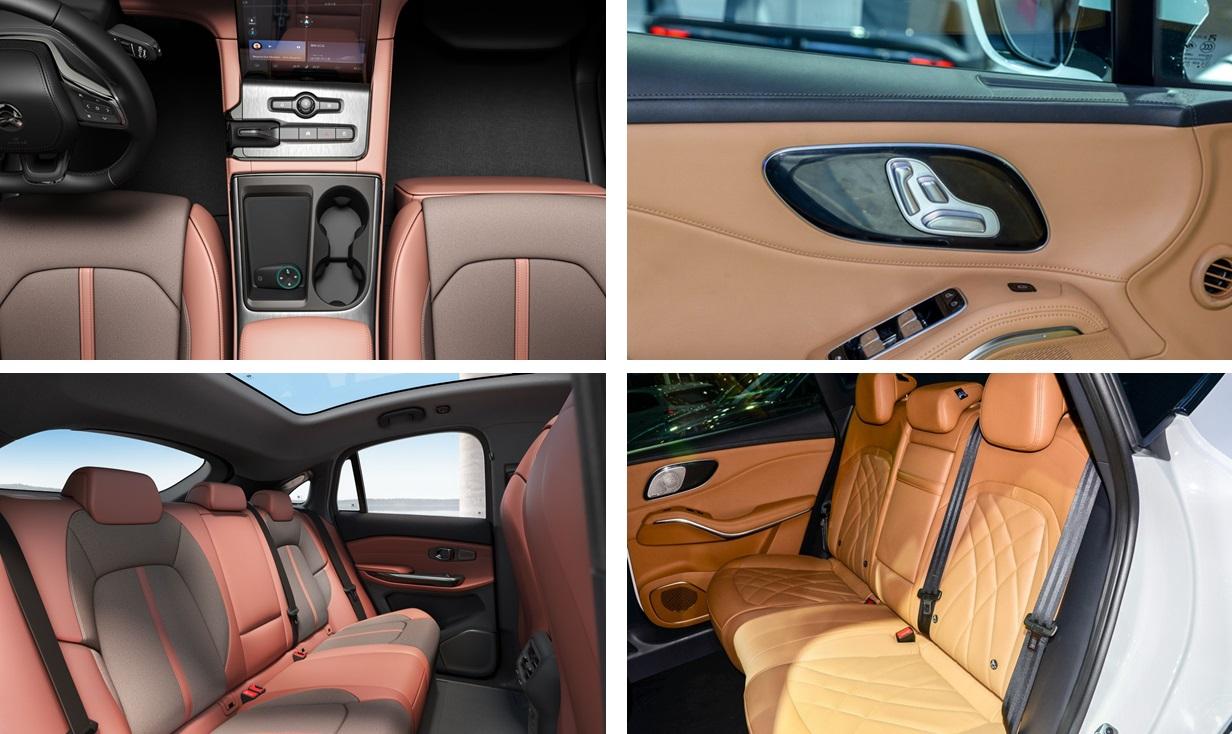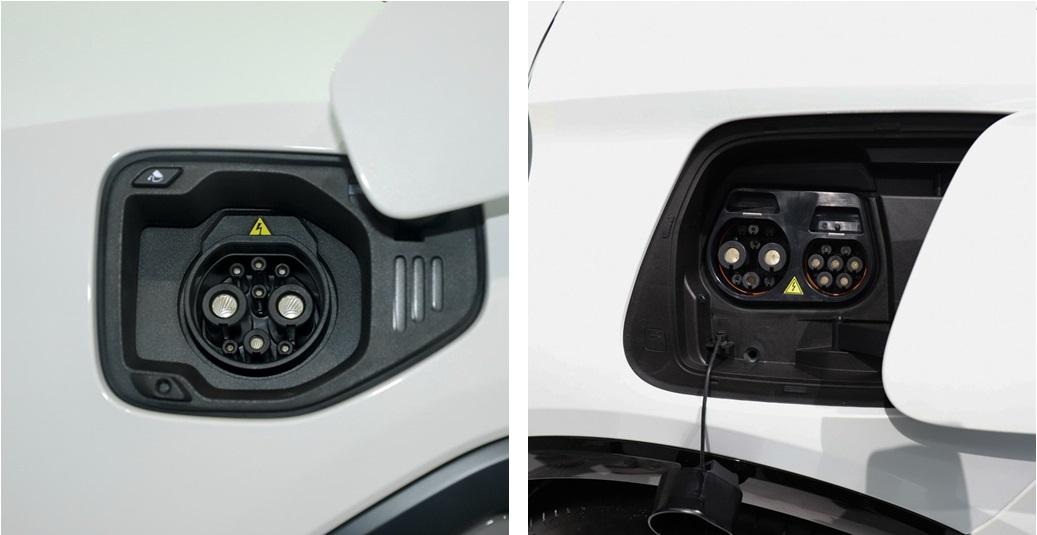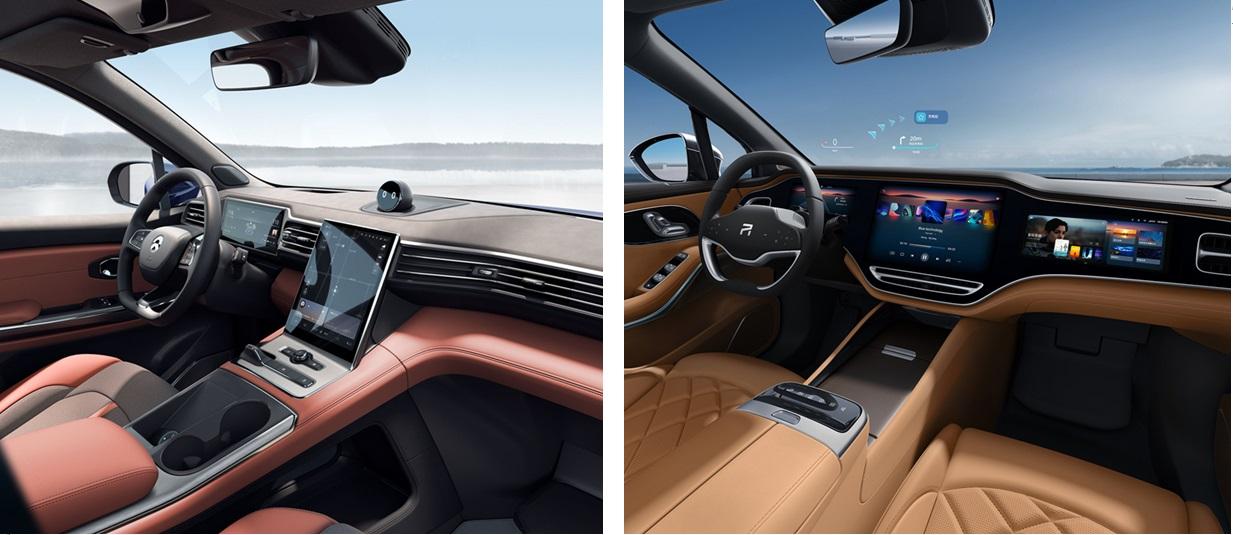In the past two years, domestic new energy vehicles have seen a new development. In addition to new car-making forces such as "NIO, Xpeng and LI", traditional independent brands are also blossoming, launching many mid- to high-end pure electric intelligent products. As a member of the traditional independent brand, SAIC Group has also launched a high-end electric brand, RISING , whose first flagship model, RISING R7, has been performing well since the beginning of booking, and according to the product information exposed one after another, RISING R7 is expected to be positioned at the 300,000-400,000RMB level, against popular models such as NIO EC6, ZEEKR 001, Xpeng G9 and Avatr 11. So who is the cost effective choice between the UE6 and the RISING R7, both of which are domestic new energy SUVs? Next let's analyze the three main parts of design, performance and technology to compare the differences between them.
NIO EC6 price vs RISING R7 price: as electric SUV, who is the cost-effective choice?
Design part
1、Appearance
Both models adopt the latest family design language, and the overall shape is minimalist and yet sporty and technological. In the front, the EC6 is equipped with an active grille with black hard decorative panels extending to the sides, making the front more layered. The RISING R7, on the other hand, has a fully enclosed design, with a "X" shape outlined by many folds, creating a good sense of science fiction. Both models have a split light system, with the EC6's narrow daytime running lights and triangular high and low beams underneath, giving it a sharp overall look. The daytime running lights on the RISING R7 are of a running style, with vertical rows of seven-star laser headlights underneath, giving a good sense of design and technology. The headlights are more functional, equipped with adaptive high and low beam, automatic headlights and headlight delay off and other configurations.
The side of the body, both adopt the more mainstream coupe SUV style, low-lying front with sliding roof design, showing a good sense of movement. The "double waistline" design makes the whole side of the body more full, while the silver frame decorative window frame, bezel-less doors and hidden door handle design is also very technological sense. At the rear, the rear of both models echoes the front of the car. The tail lights of the EC6 have a unique shape and the folding line design is very recognizable, while the tail lights of the RISING R7 have a three-section design and are very three-dimensional throughout the rear. The "duck-tail" design on the top, the aerodynamic kit on both sides of the middle and the bumper diffuser on the bottom combine to further enhance the sporting effect of the rear.

NIO EC6 interior: has a much weaker sense of technology
Interior
The interior design of the two models is very trendy, simple and without losing the sense of technology. The center control part adopts a "T-shaped" layout, with black and brown color scheme to show the atmosphere. The EC6 has a layered air conditioning vent design, while the RISING R7's integrated layout is also very integral. The functional area retains some physical buttons, but the difference is that the NIO EC6's buttons are located below the center console screen, while the RISING R7's buttons are located in front of the center armrest box (also known as the Touch bar), supporting one-touch driver's seat leveling, 360° panoramic view, driving mode switching, one-touch rest screen and one-touch mute. For the hardware part of the technology configuration, the NIO EC6 comes with a 9.8-inch full LCD instrument cluster and 11.3-inch suspended center screen, while the RISING R7 has a large through-trunk screen, with a 10.25-inch full LCD instrument cluster, a 15.05-inch center screen and a 12.3-inch passenger screen, both models are equipped with excellent performance, but the latter has a stronger sense of technology.
Space
The EC6 is a mid-size SUV with a length, width and height of 4850mm, 1965mm and 1714mm (1731 for the Sport version) and a wheelbase of 2900mm, which is a medium to high level among competing models. The R7 is a mid-size SUV with a slightly conservative body size of 4900mm, 1925mm, 1655mm and a wheelbase of 2950mm. The front row space is more than adequate, 177cm person sitting in the front seat, head space left about a fist. The rear row is also spacious, but the NIO EC6, with its superior height, has a fist and two fingers of headroom, while the RISING R7, with its superior wheelbase, has a fist and four fingers of legroom. The luggage compartment of both models has a large opening, making it easy to access items. The regular volume of the NIO EC6 is 510L, slightly larger than that of the RISING R7, and the rear seats support a 40:60 ratio.
4、Ride experience
The NIO EC6 comes standard with leather-woven hybrid seats (with optional Nappa leather seats), while the RISING R7 is equipped with NAPPA leather one-piece seats, with the latter having a better textural experience. The front seats of both cars are wide and ergonomically designed, with relatively full internal padding and good support and wrapping. Rear seat comfort is not bad, the cushion length is moderate, the front end is slightly elevated, the leg support is more adequate, the middle seat comfort is general, the internal padding is slightly thinner than the two sides, but the good thing is that the central floor is relatively flat, and are equipped with headrests.
The front seats are electrically adjustable and heated, while the NIO EC6 has a memory function and the RISING R7 supports ventilation and massage functions. The driver's seat is equipped with lumbar adjustment, the passenger seat of the EC6 also supports lumbar adjustment, while the RISING R7 also supports electric leg-rest and heated footrest. It is worth mentioning that the seat adjustment buttons on the RISING R7 are placed in the inner door panel where the buckle is located, which I feel is more intuitive and easier to operate than the traditional base adjustment on the NIO EC6.
NIO EC6 power vs RISING R7 power: as dual motor electric car, do they have enough performance and range?
Second, the performance part
Power
Take the top model as an example, both models are equipped with dual front and rear motors, and the front motors are permanent magnet synchronous motors, while the rear motor type is slightly different, with the NIO EC6 using a relatively low-cost AC asynchronous motor and the RISING R7 using a permanent magnet synchronous motor. In terms of performance parameters, both models have the same total electric motor power of 400kW (544hp), but the maximum power of the front and rear motors are slightly different: 160kW and 240kW for the NIO EC6 and 150kW and 250kW for the RISING R7. The total torque of the EC6 is 725N-m, with an official acceleration time of 4.5s, while the total torque of the R7 is 700N-m, with an official acceleration time of 4.4s. From the parameters alone, the power performance of the two models is relatively similar, but the total torque of the EC6 is slightly higher, while the acceleration ability of the R7 is slightly stronger.
Battery and range
The NIO EC6 has a larger battery capacity of 100kWh (90kWh for the RISING R7), but it also takes longer to charge, with fast charging taking 0.8 hours (0.5 hours for the RISING R7) and slow charging taking 14 hours (10 hours for the RISING R7). In terms of range, the NIO EC6 has a NEDC range of 615km and consumes 17.3kWh/100km, while the RISING R7 has a maximum pure electric range of 642km and consumes 15.8kWh/100km. range is slightly superior.

Suspension
The front suspension of RISING R7 is relatively conventional McPherson independent suspension, while the NIO EC6 has a slightly more advanced dual-arm independent suspension, and the rear suspension is multi-link independent suspension. The chassis tuning is relatively tight, relatively easy to drive at low speeds, the steering wheel has a clear road feel, and when driving at high speeds or cornering at high speeds, you can feel the chassis is relatively tough and has good filtration of fine vibrations, and when encountering bumpy roads with large undulations, the vehicle does not have a more pronounced aftershock. It is worth mentioning that the EC6 is equipped with a variable suspension system as standard, which can adjust the chassis according to the actual road conditions, and a height-adjustable air suspension system in the middle and high end models, which is more high-end than the traditional mechanical suspension, but it also requires higher requirements for the car environment and assembly process.
RISING R7 is winning in intelligent connectivity
Third, the technology part
Intelligent connectivity
For the hardware part, besides the 9.8-inch dashboard and 11.3-inch center screen, the signature version of the NIO EC6 is also equipped with a 2.18-inch full circle screen above the center console, which is the expression display of the intelligent system NOMI Mate. The center screen has a black background, the UI interface is relatively beautiful, the toolbar is located below the screen, the operation is relatively easy, but the black box at the bottom is a bit big, it would be better if it can be optimized again. RISING R7 adopts the mainstream triplex screen, with an overall size of 43 inches, and the triplex screen adopts a one-piece glass encapsulation process, with a strong sense of integrity. The central control screen adopts adaptive light-sensitive interface, the whole is relatively simple and fresh, the anthropomorphic Icon design and anthropomorphic card design are very innovative, AMOLED screen is delicate and elastic to the touch.
In terms of center screen resolution, the NIO EC6 has a resolution of 1600×1400 pixels, while the RISING R7's AMOLED flexible center screen has a resolution of 2560*1600 pixels. In terms of the car chip, both models are equipped with the same Qualcomm Snapdragon 8155 automotive grade chip. In addition, both cars are equipped with enhanced flat-screen display (HUD), but the RISING R7 is equipped with Huawei's AR-HUD flat-screen system, which is more advanced than the traditional HUD system, such as 13°*5°maximum view angle, 1920×730 resolution and automatic adjustment of HUD lighting brightness. It also covers a wide range of application scenarios, in addition to displaying relatively basic speed information, speed limit information, lane information and road names, as well as AR navigation guidance, intelligent driving safety assistance, convenient service applications and in-car infotainment functions.
The software part is better for both models, with AI intelligent voice supporting many personalized functions in addition to the regular functions such as multimedia system, navigation system, phone, and air conditioning. The NIO EC6 is equipped with NOMI Mate 2.0 AI system (still NOMI Halo in the low and mid-range, but supports optional), which supports more than 700 voice commands and more than 500 experience scenarios, and supports voice interruption, continuous dialogue, control of fragrance system, control of car recorder, adjustment of driving mode and sound field mode, etc. In addition to this, it can also, according to the dialogue scenario, come In addition, it can also change the small expression on the screen according to the dialogue situation.
RISING R7 is equipped with RISING OS intelligent cabin interaction system, which can recognize more than 500 kinds of common commands with high recognition rate and timely feedback, and also supports dialect conversation (Shanghai/Cantonese/Sichuan etc.), Chinese/English mixing, full-scene speech, continuous conversation, voice interruption, contextual understanding and using mouth instead of hand, etc. In terms of information connectivity, the four screens (instrument screen, center control screen, passenger screen and AR-HUD) of the RISING R7 can realize entertainment information sharing and passenger navigation sharing, and I personally feel that the latter is more practical as it can synchronize to the instrument screen, center control screen or AR-HUD flat-screen system with one click after setting the navigation route on the passenger screen. In terms of vehicle control, both models have complete cell phone APP functions, such as door control, vehicle start, air conditioning temperature control, charging management, vehicle location/car search, car condition inquiry and many personalized owner services.

Intelligent safety
Both models are fully equipped with conventional features such as ABS anti-lock, stability control, traction control, brake-force distribution, brake assist, 360°reversing camera, front and rear parking radar, tire pressure monitoring system, automatic parking, uphill assist and steep hill descent, as well as forward collision warning, lane departure warning, DOW door opening warning, fatigue driving tips, reverse vehicle side warning The car is equipped with high-end practical features such as forward collision warning, lane departure warning, DOW door opening warning, fatigue driving alert, reverse side warning, lane keeping assist system and road traffic sign recognition.
Intelligent assisted driving
The NIO Pilot assisted driving system of the NIO EC6 and the RISING PILOT assisted driving system of the RISING R7 can both reach the L2 level, although they still have some differences in terms of hardware. The intelligent sensory system Alder-Akiyo of the EC6 is equipped with 8 cameras (3 forward sensing cameras, 4 3-megapixel surround view cameras and 1 in-car knowing camera), 5 millimeter wave radars and 12 ultrasonic radars, which is still a relatively good overall performance. The intelligent sensory system PP-CEMTM of RISING R7 is equipped with 33 sensing hardware, including 12 8-megapixel cameras, 4 Hella enhanced long-range point cloud angle radars, 6 ultrasonic radars in front and rear, 2 ZF Premium 4D imaging radars and 1 luminar high-gauge lidar, etc. Among them, luminar high-gauge lidar adopts 1550nm light source technology, the farthest detection distance is up to 500 meters, while the Premium 4D imaging radar is sensed by electromagnetic waves, which not only detects farther than ordinary millimeter wave radar, but also the radar can still operate normally in extreme weather with low visibility such as clump fog and heavy rain.
The chip and the arithmetic power are also different, the Azure EC6 is equipped with Mobileye EyeQ4 chip (2pcs), the single chip arithmetic power is 2.5TOPS, the total arithmetic power is only 5TOPS, compared to other models in the same class, its arithmetic power performance is a little stretched, but the good thing is that it supports remote vehicle software upgrade, can be continuously updated. It is worth mentioning that the Fevan R7 is also very bright in perceptual fusion algorithm, it uses Full Fusion algorithm function algorithm system, which can integrate three fusion algorithms (pr-fusion, post-fusion and hybrid fusion). fusion and hybrid fusion) for integration, which is faster and more accurate than conventional smart driving algorithms.
Summary
Overall, the overall performance of both the NIO EC6 and the RISING R7 is excellent, although there are still some differences in some details and technical aspects. For example, the NIO EC6 has a larger battery capacity, a more advanced suspension system (dual plug-arm independent suspension, variable suspension, air suspension) and more diversified products, and it also has an advantage in terms of brand recognition. However, relying on SAIC' s RISING R7, it has a stronger sense of luxury in its interior design, a larger integrated triple screen with AR-HUD is also more technological, and it also has more advantages in terms of intelligent assisted driving hardware and chip arithmetic, so RISING R7 also has the potential to impact the market. Finally, combining the performance of the three major parts of the two models, namely design, performance and technology, as well as the future market development trend, which one will you like more?







